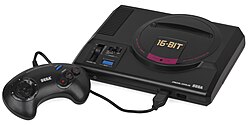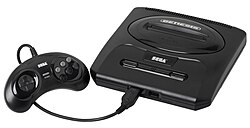
Back Mega Drive AN ميجا درايف Arabic سيجا جينسيس ARZ Mega Drive AST Sega Mega Drive Byelorussian Sega Mega Drive Bulgarian Mega Drive Breton Sega Mega Drive Catalan سێگا جێنیسیس CKB Mega Drive Czech
 | |
| |
| Developer | Sega |
|---|---|
| Manufacturer | Sega |
| Type | Home video game console |
| Generation | Fourth |
| Release date | |
| Lifespan |
|
| Introductory price | ¥21,000 (equivalent to ¥24,600 in 2019) US$189 (equivalent to $460 in 2023) £189.99 (equivalent to £550 in 2023) |
| Discontinued |
|
| Units sold |
|
| Media | ROM cartridge |
| CPU |
|
| Memory | 64 KB RAM, 64 KB VRAM, 8 KB audio RAM |
| Display | |
| Sound | |
| Online services | |
| Best-selling game |
|
| Backward compatibility | Master System[a] |
| Predecessor | Master System |
| Successor | Sega Saturn |
| Related | Sega CD 32X |
The Sega Genesis, known as the Mega Drive[b] outside North America, is a 16-bit fourth generation home video game console developed and sold by Sega. It was Sega's third console and the successor to the Master System. Sega released it in 1988 in Japan as the Mega Drive, and in 1989 in North America as the Genesis. In 1990, it was distributed as the Mega Drive by Virgin Mastertronic in Europe, Ozisoft in Australasia, and Tectoy in Brazil. In South Korea, it was distributed by Samsung Electronics as the Super Gam*Boy and later the Super Aladdin Boy.[c]
Designed by an R&D team supervised by Hideki Sato and Masami Ishikawa, the Genesis was adapted from Sega's System 16 arcade board, centered on a Motorola 68000 processor as the CPU, a Zilog Z80 as a sound controller, and a video system supporting hardware sprites, tiles, and scrolling. It plays a library of more than 900 games on ROM-based cartridges. Several add-ons were released, including a Power Base Converter to play Master System games. It was released in several different versions, some created by third parties. Sega created two network services to support the Genesis: Sega Meganet and Sega Channel.
In Japan, the Mega Drive fared poorly against its two main competitors, Nintendo's Super Famicom and NEC's PC Engine, but it achieved considerable success in North America, Brazil, and Europe. Contributing to its success was its library of arcade game ports, the popularity of Sega's Sonic the Hedgehog series, several popular sports franchises, and aggressive youth marketing that positioned it as the cool console for adolescents. The 1991 North American release of the Super Nintendo Entertainment System triggered a fierce battle for market share in the United States and Europe known as the "console war".[4][5] This drew attention to the video game industry, and the Genesis and several of its games attracted legal scrutiny on matters involving reverse engineering and video game violence. Controversy surrounding violent games such as Night Trap and Mortal Kombat led Sega to create the Videogame Rating Council, a predecessor to the Entertainment Software Rating Board.
30.75 million first-party Genesis units were sold worldwide. In addition, Tectoy sold an estimated 3 million licensed variants in Brazil, Majesco projected it would sell 1.5 million licensed variants of the system in the United States and smaller numbers were sold by Samsung in South Korea. By the mid-2010s, licensed third-party Genesis rereleases were still being sold by AtGames in North America and Europe. Many games have been re-released in compilations or on online services such as the Nintendo Virtual Console, Xbox Live Arcade, PlayStation Network, and Steam. The Genesis was succeeded in 1994 by the Sega Saturn.
- ^ "Shaw Wallace to manufacture and market Sega TV games in India".
- ^ Sonic the Hedgehog GameTap Retrospective Pt. 3/4. GameTap. February 17, 2009. Event occurs at 1:25. Archived from the original on July 21, 2016. Retrieved September 24, 2011. cf. "Review: Sonic Jam". Sega Saturn Magazine. No. 22. August 1997. p. 68.
The original Megadrive game sold over 14 million copies.
- ^ Boutros, Daniel (August 5, 2006). "A Detailed Cross-Examination of Yesterday and Today's Best-Selling Platform Games". Game Developer. Archived from the original on November 20, 2015. Retrieved May 20, 2022.
- ^ Cite error: The named reference
IGNHistory2was invoked but never defined (see the help page). - ^ Cite error: The named reference
segacdwas invoked but never defined (see the help page).
Cite error: There are <ref group=lower-alpha> tags or {{efn}} templates on this page, but the references will not show without a {{reflist|group=lower-alpha}} template or {{notelist}} template (see the help page).

